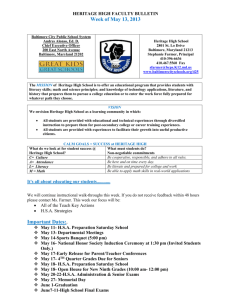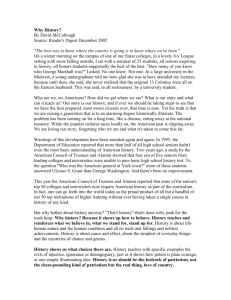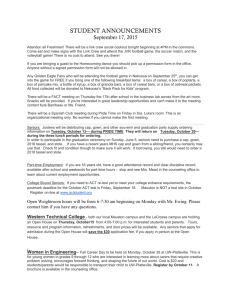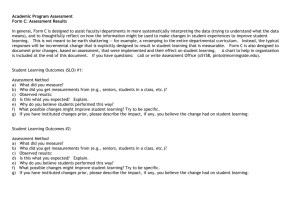Summary (by Marie Avellino and George Cassar
advertisement
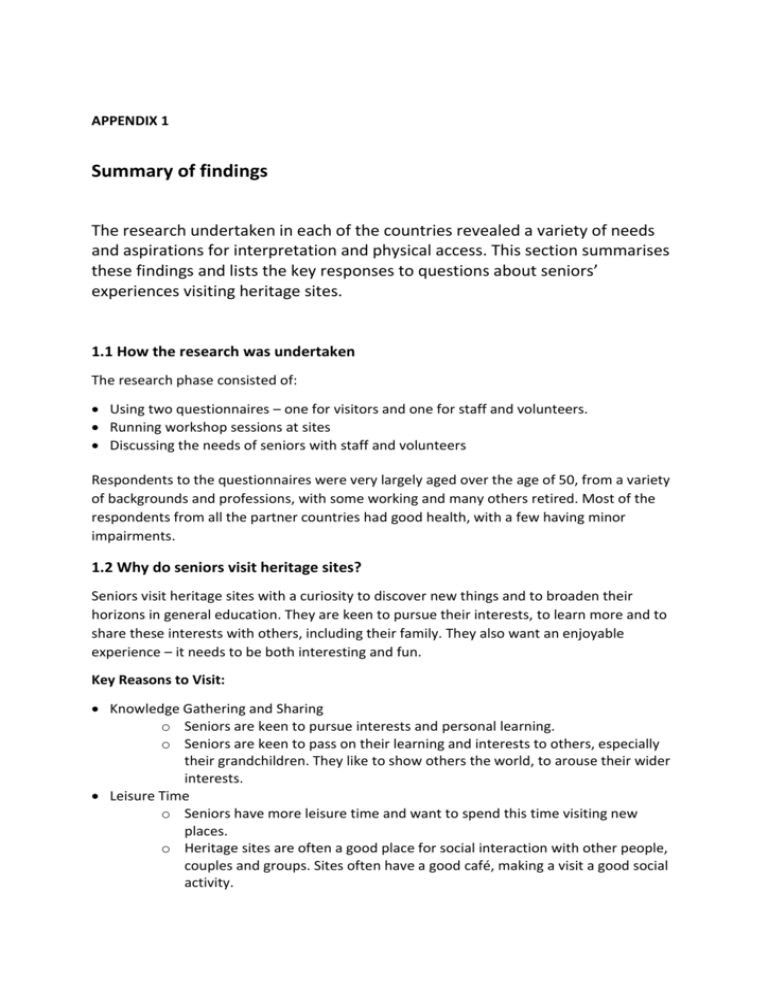
APPENDIX 1 Summary of findings The research undertaken in each of the countries revealed a variety of needs and aspirations for interpretation and physical access. This section summarises these findings and lists the key responses to questions about seniors’ experiences visiting heritage sites. 1.1 How the research was undertaken The research phase consisted of: Using two questionnaires – one for visitors and one for staff and volunteers. Running workshop sessions at sites Discussing the needs of seniors with staff and volunteers Respondents to the questionnaires were very largely aged over the age of 50, from a variety of backgrounds and professions, with some working and many others retired. Most of the respondents from all the partner countries had good health, with a few having minor impairments. 1.2 Why do seniors visit heritage sites? Seniors visit heritage sites with a curiosity to discover new things and to broaden their horizons in general education. They are keen to pursue their interests, to learn more and to share these interests with others, including their family. They also want an enjoyable experience – it needs to be both interesting and fun. Key Reasons to Visit: Knowledge Gathering and Sharing o Seniors are keen to pursue interests and personal learning. o Seniors are keen to pass on their learning and interests to others, especially their grandchildren. They like to show others the world, to arouse their wider interests. Leisure Time o Seniors have more leisure time and want to spend this time visiting new places. o Heritage sites are often a good place for social interaction with other people, couples and groups. Sites often have a good café, making a visit a good social activity. o Seniors like to have a ‘grand day out’ and to take their grandchildren to an interesting place. Many come to sites on an organised coach tour. Personal Connections o Many seniors find history meaningful and interesting. Some have personal connections with a site that stimulates their interests. o Some want to ‘re-live history’ visiting somewhere they knew earlier in their lives. o Many want to have a connection with the past. They like to reminisce about former times and to relate their memories and experiences to the features at the heritage site. o Many people like to visit places they have seen in TV dramas and programmes. 1.3 How do seniors find out about heritage sites? People find out about heritage sites in many ways. The survey found that the main sources of information for seniors are friends, family and other contacts, and from advertisements and media, including the internet. The main ways people find out about heritage sites are: Through recommendations from friends and family Through surfing the internet. Through the media including television, radio and newspapers. Through advertisements Through passing the site in the travels. Many respondents also said that they knew about the site from a previous visit to the area and wanted to find out more. 1.4 What are the best experiences for senior audiences? A good first impression when visiting a site is often vital in creating the best experiences for seniors, along with good interaction with staff and volunteers. The key points from the survey include: Convenient public transport Good seating Good signage and communication with documentaries, etc Toilets: clean, accessible Good lighting for reading signs as well as large fonts, or good electronic guides with the capacity to have a high volume controls, guidebooks with large fonts. Friendly and informative staff. High quality interpretation that seniors can relate to. Opportunities for social interaction. Reduced fees for seniors and their carers were also indicated ‘We try to make a visitor feel welcome and able to ask questions without feeling uncomfortable. We try to interact with our visitors in a friendly manner to put them at their ease.’ 1.5 What are worst experiences for senior audiences? The worst experiences for senior visitors at heritage sites are generally related to bad visitor services and poor interpretation. They include: Initial information that is not accessible. Displays that are too technical or overly computer-based. Maps or guides that are unclear and result in people feeling uncertain where they are and how long it will take to get back to where they started. Lack of facilities – parking, toilets, seats, rails, lifts, etc. Lack of clear and simple signage. Noise and crowds, and a low tolerance of younger visitors. Occasionally, numbers of children. Inadequately controlled school groups. Lack of information/interpretation in other languages. Bored, unenthusiastic museum employees. Staff and volunteers talking down to senior visitors as if they are children. High prices. Cost of entry Poor opening times. Lack of direction to the site. Things not working well – e.g.: lifts. 1.6 What are the key needs of senior audiences at heritage sites? What are seniors’ physical needs? A very large proportion of the over 55s are able bodied and have few specific physical needs. The senior respondents to the questionnaires highlighted issues that most visitors appreciate: good directions, good quality cafes and toilets and clear information about where they can go and what they can do there. The key points from the survey are: Clear directions around the site. Toilets, cafés. Good physical accessibility, with good signage. Knowledgeable/friendly staff. Information on how far visitors need to walk and how easy it is to experience the site. Easy transport links to, and around, the site. Hire of mobility and audio aids. An audio guidebook is very useful for people with visual impairments. Personal assistance from a volunteer or member of staff. Places to sit, handrails, few steps and good lighting. Somewhere to sit that is quiet. Good quality catering. Some mobility equipment is very big and heavy so there needs to be space in lifts and corridors. Being allowed time to keep up with a group in a tour. Real objects to view and touch, not just virtual objects and on-screen / sensory displays. A good sense of personal safety. ‘Clear indication of the availability of a signing audio guide for the deaf.’ What are seniors’ intellectual needs? Many respondents to the questionnaires in all partner countries stressed the importance of a high quality guide with good general knowledge of the site, who can arouse interest in the site and ‘bring it alive’. This personal approach to interpretation was considered the most important of all the ‘media’ for interpretation. Guides must speak clearly, briefly, and to the point and to deliver interpretation as a ‘conversation’ with the visitor, not just a monologue. It is not always necessary for interpretation to be simple, it is more important that it stimulates reflection and relates to life experiences. Seniors like to develop their own thinking rather than to told messages. The main intellectual needs are: A good welcome to invite them into a site. Friendly one-to-one information and answers. Personal attention, including talks and tours with presentations and guides, and staff/volunteers around the site who can help and provide information. Information that is easily comprehensible by everyone. Excellent and diverse content that they can relate to. Design that aids good understanding. Association with the items on display. Well presented exhibitions that tell a story. Experiencing history from the perspective of being able to imagine and therefore understand better the historical event. A place to remember their history. Interpretation that stimulates an emotional connection to the home region or holiday destination. Opportunities to prove, confirm and enhance knowledge. Seniors, and people generally, like to be engaged with by staff/volunteers, to ask them questions and establish an interest. It’s good to use a ‘hook’ to grab interest. Even if seniors use the internet to gather information about a site they generally prefer personal interpretation and traditional media at the site. People don’t want too much information, and too technical information. ‘Talk to them as equals. They are usually better informed and more knowledgeable than younger visitors.’ What are seniors’ emotional needs? Many respondents said they really appreciated opportunities to reflect on their experiences at a heritage site and to reminisce about events earlier in their lives or the lives of their relatives. Seniors enjoy immersing in stories that do not necessarily need to be easy to understand and to recognise features and stories from their knowledge and backgrounds. The key emotional needs are: Personal ties: the heritage site may be a person’s favourite place, a special part of their own personal history, or national history. People take pride in their own heritage. Reflecting on personal experiences, for example a war memorial. Heritage sites can often be good places to celebrate or commemorate an anniversary. Overall presentation of the site and its history. The Wow! Factor is very important. The vivid reconstruction of a site is important. ‘Ask if they have personal memories connected with the place.’ What are seniors’ social needs? Heritage sites are clearly important places to stimulate interests, spend time with friends and family and to share common interests in arts, culture and environment. The social element is therefore very important as a motivation for senior visitors to heritage sites. The key social needs are: A congenial place to be with family and friends, and particularly grandchildren. A place for a celebration, or because their ancestors had a connection with the site. A café to spend some relaxing time with other people. Pleasurable surprises, personal engagement with staff/volunteers, nice experiences. What are seniors’ cultural needs? Heritage sites often have a strong association with the culture of a place or a country. Museums have artefacts of local or global cultures, while places of natural heritage often exhibit the impact of human cultures over time. The connections made by senior visitors to these cultural elements are important, and are valued as a component of a satisfactory visit. The key cultural needs are: Interpretation with context – not just facts about the site or the collection but setting the scene in geographical terms and in world events so there is wider understanding. Nostalgia element of visiting a heritage site. Interpretation provided in different languages, even if just a simple A4 introductory sheet explaining the key interests of the site. 1.7 What type of interpretation works best for seniors? Interpretation of sites can be provided in many forms, through guided tours, brochures and exhibitions, and by audio and digital presentations. The surveys found that the personal approach, through tours and guides, was the most popular and most used by senior visitors. The internet is used extensively as a remote source of information about the site, before and after visiting. The most used forms of interpretation in order of importance (high to low) are: Guided visits Panels and exhibition labels Brochures Audio guides to rent Interactive models or devices Smart phone or tablet Interactive computer displays and touch screens Films The research undertaken in each of the countries revealed a variety of needs and aspirations for interpretation and physical access. This section summarises these findings and lists the key responses to questions about seniors’ experiences visiting heritage sites.
